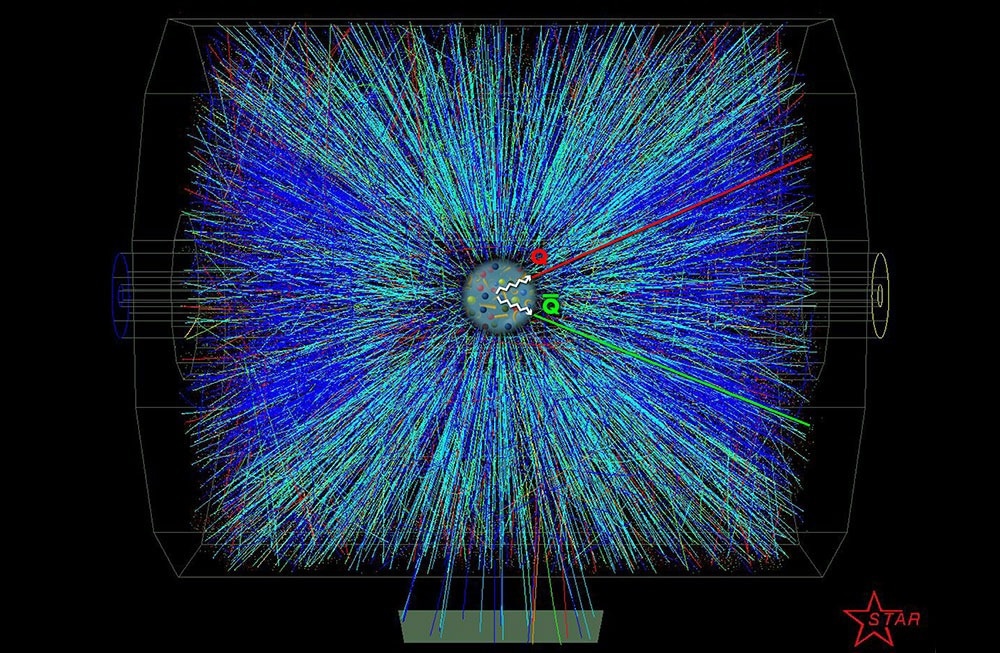In a new Topical Theory Collaboration supported by the Office of Nuclear Physics of the US Department of Energy (DOE), researchers at the Brookhaven National Laboratory will study the behavior of so-called “heavy flavor” particles.
 Tracking Heavy Quarks Collisions at the Relativistic Heavy Ion Collider (RHIC) produce a hot soup of quarks and gluons (center)—and ultimately thousands of new particles. A new theory collaboration seeks to understand how heavy quarks (Q) and antiquarks (Q-bar) interact with this quark-gluon plasma (QGP) and transform into composite particles that strike the detector. Tracking these “heavy flavor” particles can help scientists unravel the underlying microscopic processes that drive the properties of the QGP. Image Credit: Brookhaven National Laboratory
Tracking Heavy Quarks Collisions at the Relativistic Heavy Ion Collider (RHIC) produce a hot soup of quarks and gluons (center)—and ultimately thousands of new particles. A new theory collaboration seeks to understand how heavy quarks (Q) and antiquarks (Q-bar) interact with this quark-gluon plasma (QGP) and transform into composite particles that strike the detector. Tracking these “heavy flavor” particles can help scientists unravel the underlying microscopic processes that drive the properties of the QGP. Image Credit: Brookhaven National Laboratory
The “charm” and “bottom” quarks, which are heavier and rarer than the “up” and “down” quarks that make up the protons and neutrons of typical atomic nuclei, are the building blocks of these particles.
Scientists will learn more about a special kind of matter known as a quark-gluon plasma (QGP) that filled the early universe by comprehending how these exotic particles form, develop, and interact with the medium produced by strong particle collisions.
Both the Large Hadron Collider (LHC) at Europe’s CERN laboratory and the Relativistic Heavy Ion Collider (RHIC) at Brookhaven Lab conduct these experiments. Heavy atom nuclei are accelerated and smashed together by scientists at energies high enough to release the quarks and “gluons,” which act as glue and hold ordinary matter together.
These collisions produce a quark-gluon soup that closely resembles the matter that existed 14 billion years ago, just after the Big Bang.
The interaction of the quarks and gluons in the plasma is well described by a powerful theory called quantum chromodynamics (QCD). Modern research is still grappling with how these fundamental interactions result in the complex properties of the plasma, a dense medium with a trillion degrees of temperature that flows without resistance.
By creating a rigorous and thorough theoretical framework for explaining how heavy-flavor particles interact with the QGP, the Heavy-Flavor Theory (HEFTY) for QCD Matter Topical Theory Collaboration, which will be led by Ralf Rapp from Texas A&M University, aims to fill that knowledge gap.
With a heavy-flavor framework in place, experiments tracking these particles can be used to precisely probe the plasma’s properties. Our framework will also provide a foundation for using heavy-flavor particles as a probe at the future Electron-Ion Collider (EIC). Future experiments at the EIC will probe different forms of cold nuclear matter which are the precursors of the QGP in the laboratory.
Peter Petreczky, Theorist, Brookhaven National Laboratory
Heavy charm and bottom quarks are created upon the initial impact of the colliding nuclei in heavy ion collisions at RHIC and the LHC. Due to their large masses, they produce a diffusive motion that can identify the interactions present in the QGP, such as the fundamental process by which quarks combine to form composite particles known as hadrons.
“The framework needs to describe these particles from their initial production when the nuclei first collide, through their subsequent diffusion through the QGP and hadronization. And these descriptions need to be embedded into realistic numerical simulations that enable quantitative comparisons to experimental data,” Petreczky added.
The collaboration’s co-principal investigator for lattice QCD calculations will be Swagato Mukherjee of Brookhaven Lab. The complex array of variables involved in quark-gluon interactions necessitates using some of the most powerful supercomputers in the world for these calculations.
Recently there has been significant progress in lattice QCD calculations related to heavy flavor probes of QGP. We are in an exciting time when the exascale computing facilities and the support provided by the topical collaboration will enable us to perform realistic calculations of the key quantities needed for theoretical interpretation of experimental results on heavy flavor probes.
Swagato Mukherjee, Project Co-Principal Investigator, Brookhaven National Laboratory
The collaboration will employ a variety of theoretical strategies, including rigorous statistical data analysis, in addition to lattice QCD, to determine the transport properties of QGP.
The resulting framework will help us unravel the underlying microscopic processes that drive the properties of the QGP, thereby providing unprecedented insights into the inner workings of nuclear matter based on QCD.
Ralf Rapp, Project Principal Investigator, Texas A&M University
The DOE Office of Science and Office of Nuclear Physics, will provide the HEFTY collaboration with $2.5 million over the course of five years.
With the help of this funding, six graduate students, three postdoctoral fellows, and a senior staff position at one of the national laboratories will receive partial financial assistance. Additionally, Kent State University will create a bridge junior faculty position.
Brookhaven National Laboratory, Duke University, Florida State University, Kent State University, Lawrence Berkeley National Laboratory, Lawrence Livermore National Laboratory, Los Alamos National Laboratory, Massachusetts Institute of Technology, Texas A&M University, and Thomas Jefferson National Accelerator Facility are the institutions that have teamed up to collaborate on the project.